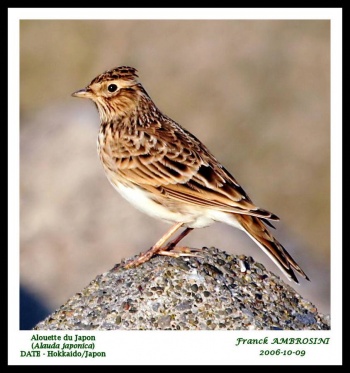- Alauda arvensis
Includes Japanese Skylark
Identification
16–19 cm (6¼-7½ in)
- Brown above with streaked back
- Buff, dark streaked breast
- Streaked crown with crest
- White belly and undertail coverts
- White supercilium
- White outer tail feathers
- Thin bill
- Pink legs
Similar Species
Similar to Oriental Skylark but can be distinguished by larger size, thicker bill, longer tail, white trailing edge to wings and whiter outer tail feathers. The primary projection is longer. Call is different.
Distinguished from Japanese Skylark by lack of rufous shoulder.
For differences between Eurasian Skylark and Meadow Pipit see this thread in Tips for New Birders Forum
Distribution
Breeds across most of Europe and Asia and in the mountains of North Africa. It is mainly resident in the west of its range, but eastern populations are more migratory, moving further south in winter. Even in the milder west of its range, many birds move to lowlands and the coast in winter. Asian birds appear as vagrants in Alaska; this bird has been introduced to Hawaii and British Columbia, Canada.
Taxonomy
Subspecies
There are 13 subspecies[1]:
European Group
- A. a. arvensis:
- A. a. scotica:
- Ireland, north-western England, Scotland and Faeroe Islands
- A. a. guillelmi:
- A. a. sierrae:
- A. a. harterti:
- Mountains of north-western Africa
- A. a. cantarella:
- A. a. armenica:
Asian Group
- A. a. dulcivox:
- South-eastern Russia to Yenisey basin and Afghanistan; >north-western India
- A. a. kiborti:
- A. a. intermedia:
- A. a. pekinensis:
- North-eastern Siberia to Sea of Okhotsk, Kamchatka Pen. and Kuril Islands
- A. a. lonnbergi:
- Shantar and Sakhalin islands (Sea of Okhotsk); winters to Japan
- A. a. japonica:
- Major islands in Japanese Archipelago; winters to the Ryukyu Islands
Habitat
Breeds in open countryside, fields, moors, rough grazing and sand dunes, etc.
Winters beside estuaries, on golf courses and cultivated land.
Behaviour
Gregarious in winters and often in large flocks. Often Dust bathes.
Diet
The diet includes seeds and insects.
Breeding
The 3-5 eggs are a dirty white colour and heavily marked with dark brown spots and blotches. They are incubated for 11-12 days; the young fledge 9-10 days later. There can be 2 or even 3 broods. The nest is well hidden in the grass.
Vocalisation
Song: is delivered from high in the sky.
References
- Clements, J. F., T. S. Schulenberg, M. J. Iliff, D. Roberson, T. A. Fredericks, B. L. Sullivan, and C. L. Wood. 2018. The eBird/Clements checklist of birds of the world: v2018. Downloaded from http://www.birds.cornell.edu/clementschecklist/download/
- mbr-pwrc.usgs
- Observer's Book of Birds' Eggs
Recommended Citation
- BirdForum Opus contributors. (2025) Eurasian Skylark. In: BirdForum, the forum for wild birds and birding. Retrieved 14 May 2025 from https://www.birdforum.net/opus/Eurasian_Skylark
External Links
GSearch checked for 2020 platform.1








